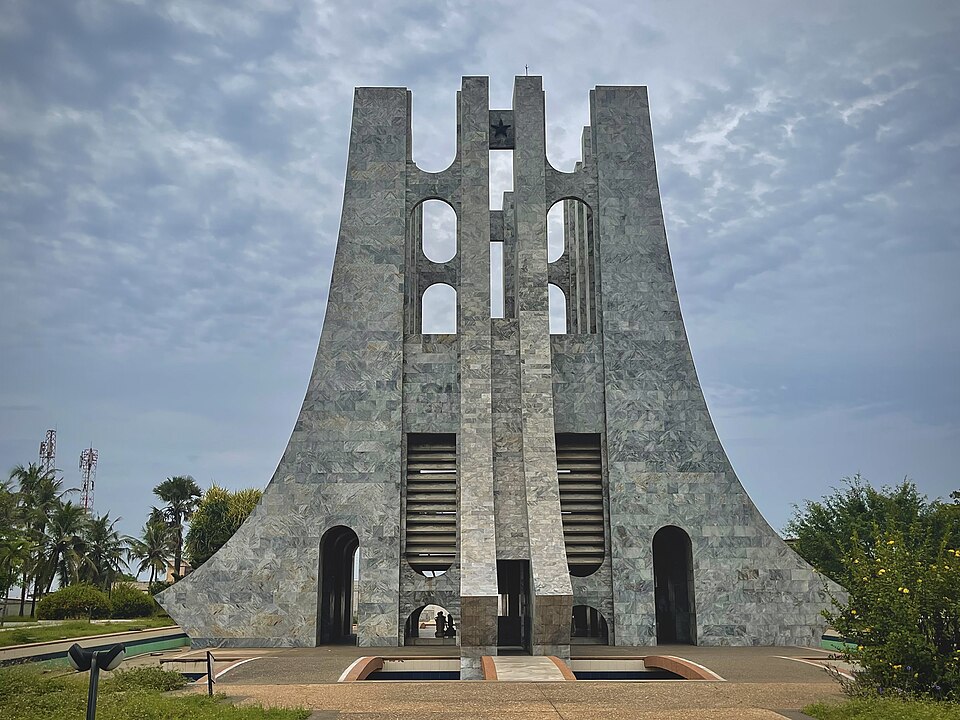Accra, the capital of Ghana, has a unique culture that blends reverence for the past with hopes for the future. Amid the bustling shops and contemporary buildings, the Kwame Nkrumah Mausoleum is a serene tribute to the life and legacy of Ghana’s first president and a pivotal figure in the Pan-African movement. The mausoleum is not only a place of burial but also a powerful symbol of a nation’s self-reliance, unity, and resilience.
The park, which is in the center of Accra, is where Kwame Nkrumah and his wife, Fathia Nkrumah, are buried. The massive building, which stands out sharply against the surrounding greenery, attracts tourists from all around the world who are keen to meet the man who guided Ghana to independence in 1957.
A Symbolic Masterpiece:
The Mausoleum’s architecture is rich in symbolism, designed to reflect Nkrumah’s ideals and the aspirations of a burgeoning nation. Shaped like an upturned sword, a symbol of peace, it represents Nkrumah’s unwavering commitment to non-violence and his belief in peaceful liberation. Clad in Italian marble, the stark white structure stands as a beacon of hope and remembrance.
Surrounding the mausoleum is a meticulously manicured park, complete with fountains, statues, and carefully placed flora. The central feature is a statue of Nkrumah, depicted in his signature cloak, boldly pointing forward, a representation of his vision for a unified and prosperous Africa.
More than a Monument, a Museum:
Outside the mausoleum, there is a museum dedicated to Kwame Nkrumah’s life and times. Visitors are guided through Nkrumah’s inner journey, from his early education in Ghana and the US to his pivotal role in the struggle for independence and his pan-African advocacy.
The museum displays a fascinating collection of artifacts, including Nkrumah’s personal belongings, original documents, photographs, and even the presidential limousine in which he famously rode. These artifacts offer a tangible connection to the past, allowing visitors to gain a deeper understanding of Nkrumah’s personality, his political philosophy, and the challenges he faced in leading a newly independent nation.
A Legacy of Pan-Africanism:
The Kwame Nkrumah Mausoleum is a representation of the larger Pan-African movement rather than merely a monument to one individual. Freedom fighters and intellectuals throughout the diaspora found great resonance in Nkrumah’s vision of a wealthy and united African continent. For those who still support his principles of economic independence, self-determination, and continental unity, the tomb acts as a meeting spot.
Visiting the Kwame Nkrumah Mausoleum:
A visit to the Kwame Nkrumah Mausoleum is an essential experience for anyone traveling to Accra. It’s a chance to pay homage to a pivotal figure in African history, to learn about the struggle for independence, and to reflect on the ongoing pursuit of Pan-African ideals.
Guided tours are available at the Mausoleum, offering insightful information about the site’s significance and history. It is advised that visitors observe the location’s seriousness and dress appropriately.
A Living Legacy:
The Kwame Nkrumah Mausoleum stands as a powerful reminder of the importance of leadership, vision, and the pursuit of justice. It is a place where history comes alive, inspiring future generations to strive for a better world. In the enter f the capital of Ghana, this monument serves not just as a tribute to a fallen leader, but as a vibrant, breathing testament to the enduring spirit of a nation and the unwavering pursuit of Pan-African ideals.
